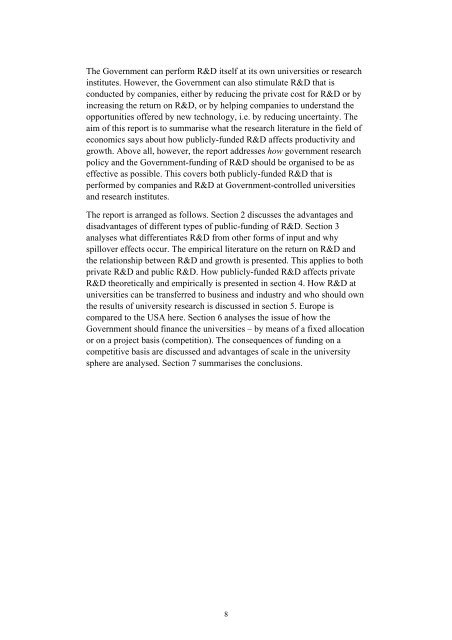Growth through Research and Development - what does ... - Vinnova
Growth through Research and Development - what does ... - Vinnova
Growth through Research and Development - what does ... - Vinnova
You also want an ePaper? Increase the reach of your titles
YUMPU automatically turns print PDFs into web optimized ePapers that Google loves.
The Government can perform R&D itself at its own universities or researchinstitutes. However, the Government can also stimulate R&D that isconducted by companies, either by reducing the private cost for R&D or byincreasing the return on R&D, or by helping companies to underst<strong>and</strong> theopportunities offered by new technology, i.e. by reducing uncertainty. Theaim of this report is to summarise <strong>what</strong> the research literature in the field ofeconomics says about how publicly-funded R&D affects productivity <strong>and</strong>growth. Above all, however, the report addresses how government researchpolicy <strong>and</strong> the Government-funding of R&D should be organised to be aseffective as possible. This covers both publicly-funded R&D that isperformed by companies <strong>and</strong> R&D at Government-controlled universities<strong>and</strong> research institutes.The report is arranged as follows. Section 2 discusses the advantages <strong>and</strong>disadvantages of different types of public-funding of R&D. Section 3analyses <strong>what</strong> differentiates R&D from other forms of input <strong>and</strong> whyspillover effects occur. The empirical literature on the return on R&D <strong>and</strong>the relationship between R&D <strong>and</strong> growth is presented. This applies to bothprivate R&D <strong>and</strong> public R&D. How publicly-funded R&D affects privateR&D theoretically <strong>and</strong> empirically is presented in section 4. How R&D atuniversities can be transferred to business <strong>and</strong> industry <strong>and</strong> who should ownthe results of university research is discussed in section 5. Europe iscompared to the USA here. Section 6 analyses the issue of how theGovernment should finance the universities – by means of a fixed allocationor on a project basis (competition). The consequences of funding on acompetitive basis are discussed <strong>and</strong> advantages of scale in the universitysphere are analysed. Section 7 summarises the conclusions.8
















